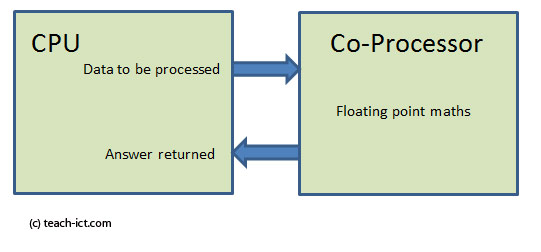 A LEVEL COMPUTING
A LEVEL COMPUTING RISC and CISC
RISC and CISC
 Theory
Theory
5. Maths co-processor
So far, we have discussed parallel processing as a means of speeding up data processing. This is fine but it does make an assumption that the Arithmetic Logic Unit (ALU) within the CPU is perfect for handling all kinds of data. And this is not always true.
There are two basic ways of doing calculations within a CPU. (a) Integer maths which only deal with whole numbers or (b) floating point maths which can deal with decimal / fractional numbers.
Large-number ranges are best handled as 'floating-point' numbers which is discussed in another mini-website.
Handling floating point numbers efficiently requires wide registers to deal with a calculation in one go. And the CPU architect may not want to dedicate precious hardware space in his CPU for these wider registers.
So the idea of a 'Maths co-processor' came about.

A co-processor is especially designed to carry out floating point calculation extremely quickly. It co-exists with the CPU on the motherboard. Whenever a floating point calculation needs to be done, the CPU hands the task over to the co-processor then carries on with doing something else until the task is complete.
The advantage of having a co-processor is that calculation (and hence performance) is much faster.
The disadvantage is that it is more expensive, requires more motherboard space and takes more power.
But if the computer is dedicated to handling heavy floating point work then it may be worth it. For instance a computer within a signal processing card in a communication system may include a maths co-processor to process the incoming data as quickly as possible.
Challenge see if you can find out one extra fact on this topic that we haven't already told you
Click on this link: Maths co-processor
Copyright © www.teach-ict.com

